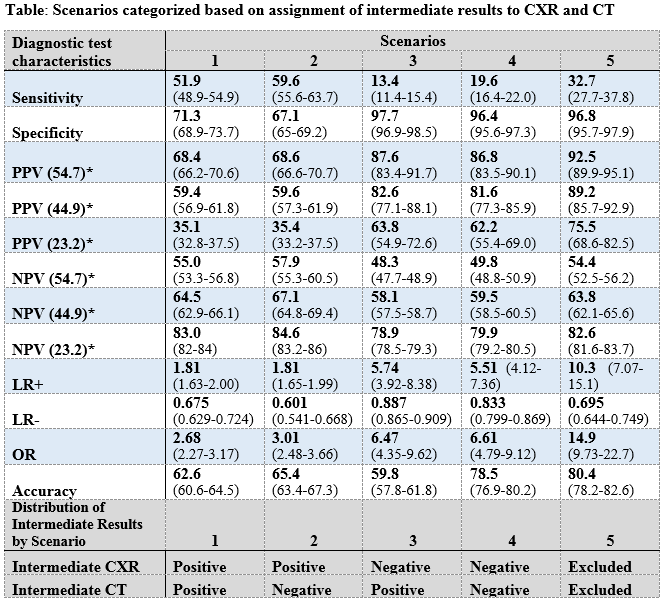Background: Currently, the chest x-ray (CXR) is the first line imaging test for identifying pneumonia and chest CT (CT) is considered the reference standard; however, prior studies have not specifically addressed intermediate results and therefore, the true value of a CXR is not known. The purpose of this study was to calculate the statistical measures of performance of a CXR for identifying pneumonia when taking into account intermediate results of both CXRs and CTs.
Methods: Retrospective analysis of 2411 patients. Statistical measures of performance of a CXR, using CT as the reference standard, were calculated by varying intermediate radiology report impressions of both the CXR and the CT to all negative or all positive, resulting in: scenario 1, CXR & CT intermediates are considered positive; scenario 2, CXR intermediates are positive but CT intermediates are negative; scenario 3, CXR intermediates are negative and CT intermediates are positive; scenario 4, CXR & CT intermediates are negative.
Results: In the analysis 7% of CXRs were positive, 32% intermediate, 61% negative. 95% confidence intervals were used.Scenario 1: sensitivity 51.9 (48.9-54.9), specificity 71.3 (68.9-73.7), positive predictive value (PPV) 59.4 (56.9-61.8), negative predictive value (NPV) 64.5 (62.9-66.1).
Scenario 2: sensitivity 59.6 (55.6-63.7), specificity 67.1 (65-69.2), PPV 59.6 (57.3-61.9), and NPV 67.1 (64.8-69.4).
Scenario 3: sensitivity 13.4 (11.4-15.4), specificity 97.7 (96.9-98.5), PPV 82.6 (77.1-88.1), NPV 58.1 (57.5-58.7).
Scenario 4: sensitivity 19.6 (16.4-22.0), specificity 96.4 (95.6- 97.3), PPV 81.6 (77.3-85.9), NPV 59.5 (58.5-60.5).
Scenario 5: sensitivity 32.7 (27.7-37.8), specificity 96.8 (95.7-97.9), PPV 89.2 (85.7-92.9), NPV 63.8 (62.1-65.6).
Conclusions: A CXR’s ability to identify pneumonia needs further clarification as results are wide ranging when accounting for intermediate results.
.png)

